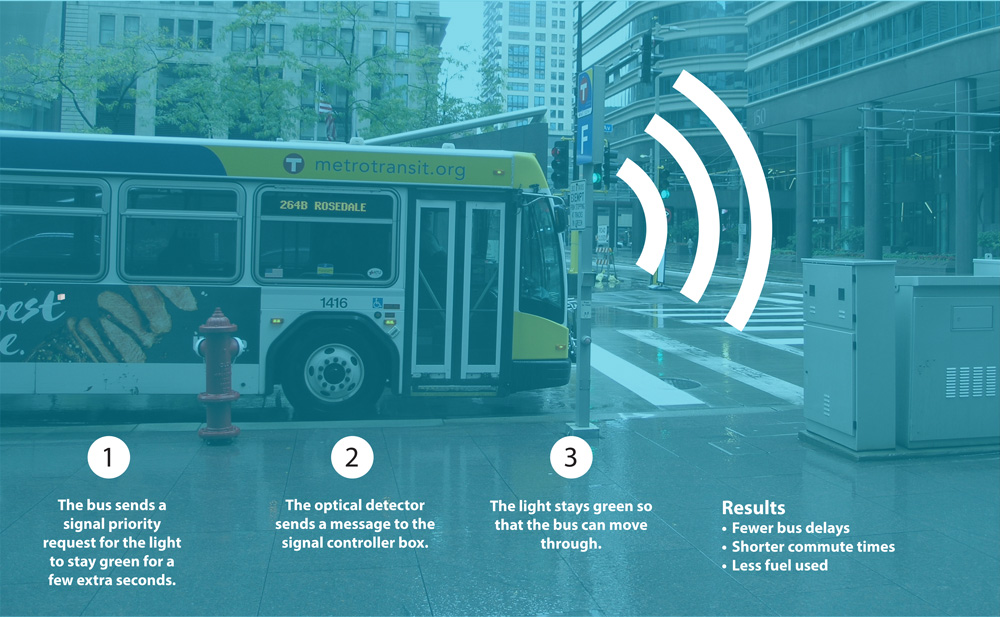Strategy 2 Increase the speed and reliability of transit.
The actions within this strategy are divided into two categories:
Action we will DOActions we will SUPPORTAction we will do are followed by “DO” and are colored in dark gray, and actions we will support are followed by “SUPPORT” and are colored in light gray.
Learn more about how we get thereMany improvements can be made to transit within City streets, and by adapting the City’s practices. Bus priority lanes, adjustments to signal timing, curb extensions or in-lane transit stops, and stop consolidation are all examples of using existing street right of way to improve speed and reliability. Large transit projects often take years to plan, design, fund and construct, and often involve multiple agencies – including city, regional, state, federal offices as well as transit operators. This 10-year action plan recognizes that while that process is valid and necessary for certain types of transit projects like light rail or BRT projects, there are other quick-build opportunities that we can identify and implement in the near term to make improvements sooner rather than later. We need to invest now in transit projects. The actions below focus on near-term opportunities to improve the transit in the city.
Transit accounts for 13.5% of all commuter trips1. Over 200,000 employees work in downtown Minneapolis each day, and 45% arrive by transit. During busy commute times, bus service becomes unreliable due to congestion during peak travel hours. An added focus on downtown is included in this chapter due to the density of trips.
Bus-only lanes refer to using one travel lane for buses only, either for a select period of time or throughout the entire day depending on context.
- 2018 American Community Survey 5-Year Estimates
Actions to increase the speed and reliability of transit.
Transit 2.1
Use full-time dedicated bus-only lanes or dynamic lanes (peak period operation) to improve the speed, frequency and reliability of transit on congested corridors.
Supported goals:
Climate Prosperity Mobility Active Partnerships
Related actions:
Difficulty:
High
Timeframe:
2020-2023 (Years 0-3)
Status:
On-going
Transit 2.2
Install a bus-only lane, and/or other transit advantages, on the following high priority corridors:
- 4th Avenue South between Washington Avenue and 10th Street South
- 5th Avenue South between Washington Avenue and 10th Street South
- 6th Street North/South between 1st Avenue North and 13th Avenue South
- 7th Street North/South between 1st Avenue North and 13th Ave South
- 8th Street North/South downtown between 1st Avenue North and 13th Ave South.
- 4th Street from the freeway connections on the west to Marquette and 2nd Avenues.
- 12th Street South between I35-W and Marquette Avenue South
Supported goals:
Climate Equity Prosperity Mobility Active Partnerships
Related actions:
Difficulty:
High
Timeframe:
2024-2027 (Years 4-7)
Transit 2.3
Evaluate the potential for a bus-only lane, and/or other transit advantages, on the following corridors, considering partnerships with other jurisdictions.
- Hennepin Avenue between Washington Ave South and 12th Street South.
- Hennepin Avenue between Franklin Ave and 12th Street South.
- West Broadway Ave from western city boundary to eastern city boundary
- Central Ave from 3rd Ave bridge to northern city boundary
- University Ave/4th St from Hennepin/1st Ave NE to eastern city boundary
- 11th Street South between Hennepin and Marquette
- 12th Street South between Hawthorne to 2nd Avenue
- Lake Street (and Lagoon Avenue) from the western city boundary to the eastern city boundary
Supported goals:
Climate Equity Prosperity Mobility Active Partnerships
Related actions:
Difficulty:
High
Timeframe:
2020-2023 (Years 0-3)
Transit 2.4
Improve transit speed and reliability throughout downtown; focus on Nicollet Mall and Marquette/2nd Avenue operations first.
Supported goals:
Climate Equity Prosperity Mobility Active Partnerships
Related actions:
Difficulty:
High
Timeframe:
2020-2023 (Years 0-3)
Status:
On-going
Transit 2.5
Plan for transit during street reconstruction projects. Ensure that road reconstruction projects on high frequency transit corridors allocate dedicated space for bus-only lanes or other transit advantages, and if applicable, integrate bus rapid transit-ready station design.
Supported goals:
Climate Equity Prosperity Mobility Active Partnerships
Related actions:
Operations 9.1, Operations 9.2, Operations 9.3, Operations 9.4
Difficulty:
High
Timeframe:
2020-2023 (Years 0-3)
Status:
On-going
Transit 2.6
Prioritize the use of curb space for transit operations and passengers and allow for dynamic flexibility depending on the time of day.
Supported goals:
Prosperity Mobility Active Partnerships
Related actions:
Operations 5.2
Difficulty:
High
Timeframe:
2020-2023 (Years 0-3)
Status:
On-going
Transit 2.7
Support transit advantages on freeways, including direct connections into and out of downtown, that rely on lane conversions instead of expansions where technically feasible and with consideration of local impacts. Direct connections into downtown should connect to streets with transit-only facilities, including from:
- Interstate 94 between downtown Minneapolis and downtown St Paul
- Interstate 94 north of downtown
- Interstate 35W north of downtown
Supported goals:
Climate Prosperity Mobility Active Partnerships
Related actions:
Difficulty:
High
Timeframe:
2020-2023 (Years 0-3)
Status:
On-going
Transit 2.8
Increase enforcement of bus-only lane operation to ensure effectiveness on existing and future routes.
- Increase targeted parking enforcement strategies for vehicles blocking current and future bus-only lanes.
- Support the implementation of automated enforcement.
Supported goals:
Equity Mobility Active Partnerships
Related actions:
Operations 6.6
Difficulty:
High
Timeframe:
2020-2023 (Years 0-3)
Status:
On-going
Transit 2.9
Increase the size of the traffic control agent workforce, assign traffic control agents in coordination with transit operators, and ensure that traffic control agents are educated and focused on equitable outcomes that increase person throughput and prioritize the movement of transit vehicles over automobiles.
Supported goals:
Climate Prosperity Mobility Active Partnerships
Related actions:
Difficulty:
High
Timeframe:
2024-2027 (Years 4-7)
